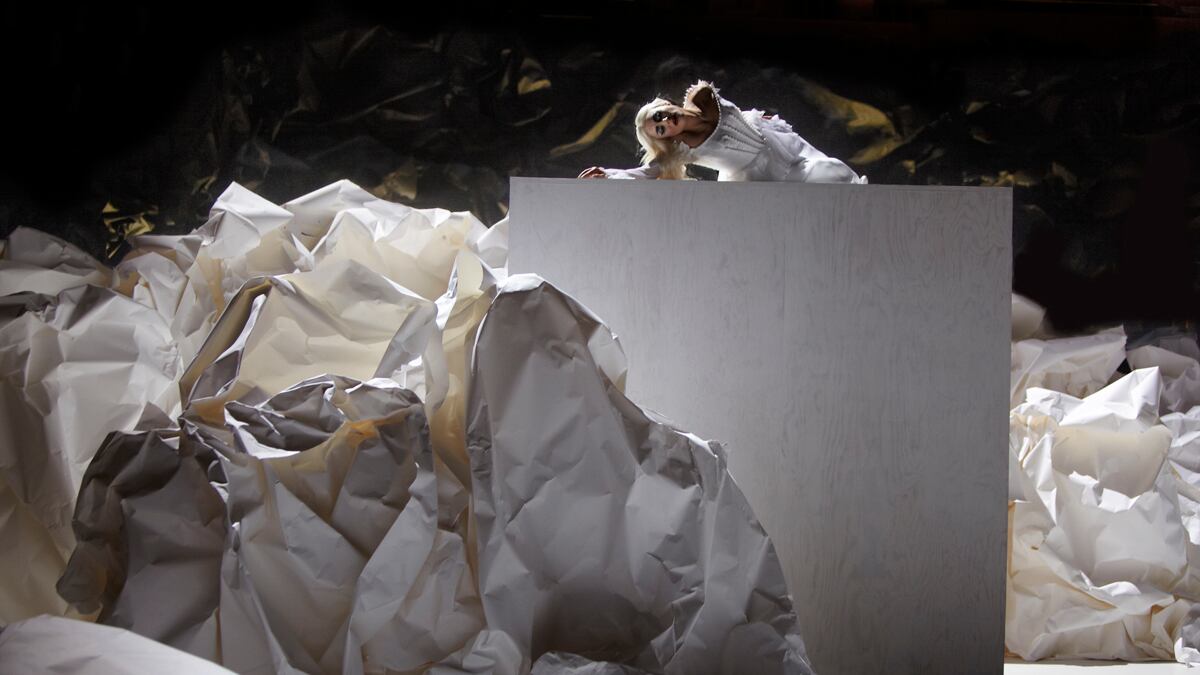
Since its debut in Prague in 1787, Mozart’s Don Giovanni has become one of the most widely performed operas in the world. But it’s never been done quite like this.
A new adaptation, which opened Friday at Walt Disney Hall in Los Angeles, redefines anything you might know about the sexually charged libretto. Performed by the L.A. Philharmonic and its world-famous conductor, Gustavo Dudamel, this latest rendition casts the 225-year-old opera in a minimalist, futuristic new light. The sets are the work of Frank Gehry, the influential architect behind Disney Hall itself as well a host of other admired buildings. The costumes are the work of sister duo Kate and Laura Mulleavy of Rodarte, who also crafted the intricate ballet outfits for Black Swan—and, for this production, used 130,000 Swarovski crystals, pearls, and beads on their fabrics.
Disney Hall was completed in 2003, but Don Giovanni is the first occasion Gehry has designed a set for the space. And though the building’s shell-like interior is engineered to enhance acoustics, an opera has never been staged there.
But you’d never suspect any of that. Gehry’s world is a cold and colorless one, with glacial walls crafted out of white crumpled sheets. These voluminous façades serve as protection for characters to eavesdrop on each other and become the metaphorical pages of Don Giovanni’s “book,” in which he keeps track of his conquests. (The character claims to have bedded 2,065 women, and 1,003 in Spain alone—numbers that would challenge even Michael Fassbender in Shame.)
Dudamel and his musicians are stationed behind the main stage. Clad entirely in black, they offset the white world of the operatic characters. There’s no interaction between the two until Don Giovanni, midfeast, commands the band to “Play! Play!” He’s talking directly to Dudamel, you realize.
The opera opens with Giovanni (Polish baritone Mariusz Kwiecien) slipping into the bedroom of Donna Anna (Carmela Remigio), a pale beauty who looks like a cross between Lady Gaga and Daenerys Targaryen from Game of Thrones. In the Mulleavys’ hands, Giovanni is a warrior from the future with ivory plastic armor strapped over a white military outfit, a slick black wig, and dramatic eye makeup that recalls Black Swan. Donna Anna’s father, the Commendatore (Stefan Kocan), rushes to protect his daughter, but Don Giovanni kills him—leaving her fiancé, Don Ottavio, vowing to avenge her father’s death.
Enter the buxom Donna Elvira (Aga Mikolaj), with black hair down to her waist, an Athena-style headpiece and a sparkling black dress. Elvira has recently been deceived by Giovanni—and decides to seek vengeance by publicly outing him as the trickster whom he is.
The actors navigate the stage on great white cubes that are managed by four stagehands dressed all in white. These cubes represent breaks in time and place and offer a minimalistic counterbalance to the craggy landscape, constantly reminding the audience that this is the work of Frank Gehry—and not just Mozart. The women are often frozen on these vertical pedestals; all Don Giovanni needs to do is shimmy around the base of the box to seduce them. Such is the case for Zerlina, a peasant maiden with purple hair and a purple cupcake dress that makes her look straight out of a Will Cotton painting.
By Act II, the Mulleavys have physically transformed each of the female characters through artfully constructed before-and-after costumes. Donna Anna’s virginal white dress is now stained with red, Elvira’s hair is tinged with gray, and Zerlina’s corset has come entirely undone. “Donna Anna, Donna Elvira and Zerlina each undergo an extreme emotional and physical transformation and we mirrored this in their costumes,” the designers wrote in an email. “The men of Don Giovanni remain constant except for Don Giovanni, who breaks from the rules and constraints of his world, and the Commandetore, who physically defies the notion of death.”
In the penultimate scene, the ghost of the Commendatore appears to Don Giovanni. Cocksure and unafraid, our protagonist does what he always does: he invites the ghost to dinner. The act finishes with Commendatore crashing a foodless and propless feast—“You invited me to supper, and I have arrived!”—and calling on Giovanni to repent for his many sins.
The actors glide around the stage like zombies on different axes and avoid eye contact—all of which challenges our sense of place and space. Can people overhear each other? Are they even in the same vicinity? There are no props, and the much-anticipated “feast” consists of the seven principals sitting on a row of white cubes, all facing different directions. There is no table, no food, and certainly no sudden movements. It’s an opera that would make performance artist Marina Abramovic proud.
The original Don Giovanni was set in Seville. This one, in the imaginative hands of Gehry, the Mulleavys, and director Christopher Alden, is in a different realm altogether. We’re suspended, for four hours at least, somewhere in the distant future.





